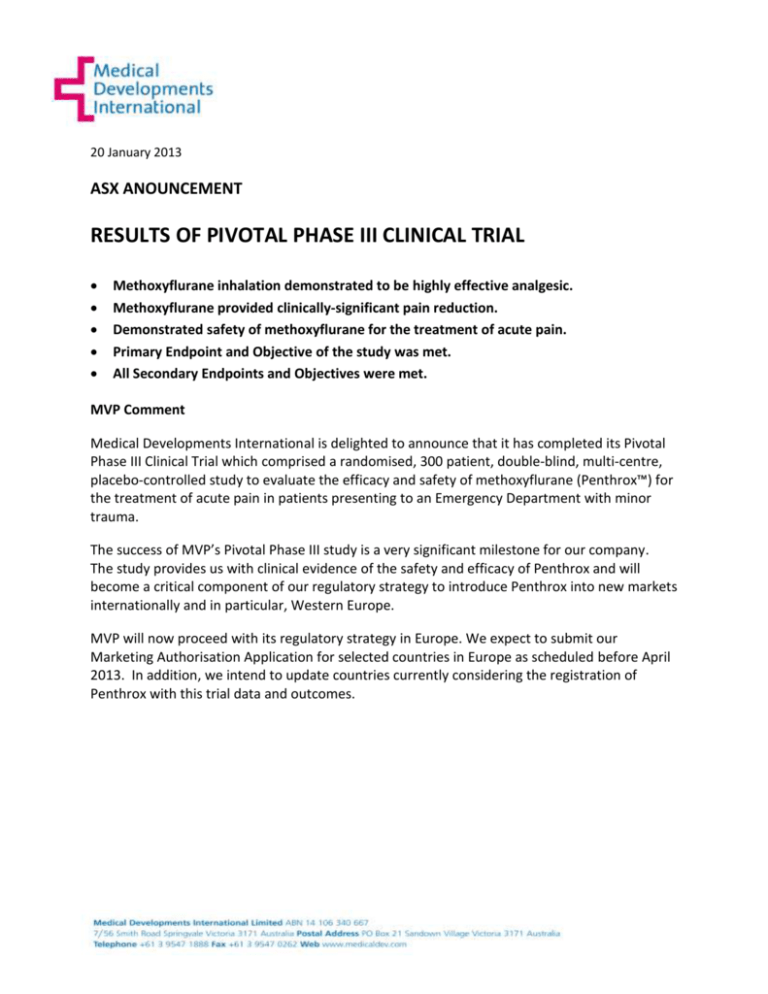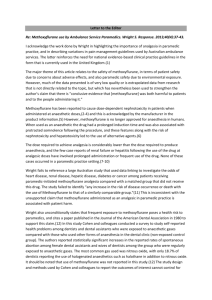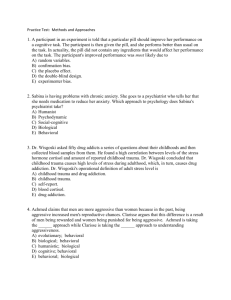MVP-ASX-Announcement-European-Clinical-Trial-Results
advertisement

20 January 2013 ASX ANOUNCEMENT RESULTS OF PIVOTAL PHASE III CLINICAL TRIAL Methoxyflurane inhalation demonstrated to be highly effective analgesic. Methoxyflurane provided clinically-significant pain reduction. Demonstrated safety of methoxyflurane for the treatment of acute pain. Primary Endpoint and Objective of the study was met. All Secondary Endpoints and Objectives were met. MVP Comment Medical Developments International is delighted to announce that it has completed its Pivotal Phase III Clinical Trial which comprised a randomised, 300 patient, double-blind, multi-centre, placebo-controlled study to evaluate the efficacy and safety of methoxyflurane (Penthrox™) for the treatment of acute pain in patients presenting to an Emergency Department with minor trauma. The success of MVP’s Pivotal Phase III study is a very significant milestone for our company. The study provides us with clinical evidence of the safety and efficacy of Penthrox and will become a critical component of our regulatory strategy to introduce Penthrox into new markets internationally and in particular, Western Europe. MVP will now proceed with its regulatory strategy in Europe. We expect to submit our Marketing Authorisation Application for selected countries in Europe as scheduled before April 2013. In addition, we intend to update countries currently considering the registration of Penthrox with this trial data and outcomes. Details for the Clinical Trial are as follows 1. The study was a Pivotal Phase III trial. 2. Primary Endpoint: To evaluate the short-term efficacy of methoxyflurane for the treatment of acute pain in patients presenting to an Emergency Department (ED) with minor trauma. The Primary Objective and Endpoint was met. 3. Secondary Endpoints: To evaluate the: a) Safety of methoxyflurane for the treatment of acute pain in patients presenting to an ED with minor trauma; b) Efficacy of methoxyflurane for the treatment of acute pain in patients with minor trauma during their time in the ED. Both Secondary Objectives and Endpoints were met. 4. Efficacy conclusions: a) There was a highly significant difference between the methoxyflurane and placebo group (p<0.0001) in the analysis of the change of VAS pain intensity score from baseline. b) There was a highly significant difference (p=0.0002) between the methoxyflurane and placebo groups in the use of rescue medication (requested by the patient) within 20 minutes of the start of treatment. c) The median time to first pain relief for the methoxyflurane group was 4 minutes. This compares with the median time to onset of meaningful pain relief for intranasal fentanyl of 11 minutes and 16 minutes for oromucosal fentanyl. A total of 126 patients (84.6%) in the methoxyflurane group experienced their first pain relief with 1-10 inhalation. d) Overall, the study results demonstrate a highly significant treatment effect by all efficacy analysis. 5. Safety conclusions: a) The study treatment (methoxyflurane or placebo) was well tolerated during the study with no deaths and only one serious Treatment Emergent Adverse Event (TEAE) which was unrelated to the study or the study drug. b) The number of patients experiencing TEAEs leading to the withdrawal of study treatments was lower in the methoxyflurane group (1.3%) compared to the placebo group (2.0%). c) There was little change in systolic blood pressure, diastolic blood pressure, respiratory rate, heart rate, heart rhythm (regular and irregular rhythm specified) between the evaluation in patients in the methoxyflurane group. The results were comparable to that of the placebo group. d) Overall, methoxyflurane was well tolerated with the majority of adverse reactions being mild, transient and in line with anticipated pharmacological action. Patients successfully completed treatment with no relevant difference in incidence, severity or proportion of events leading to withdrawal between the methoxyflurane and placebo groups. 6. Global Medication Performance The Global Medication Performance (GMP) is the assessment by the patient, physician and research nurse following the completion of the Emergency Department visit. a) 83.3% of patients assessed the GMP as good, very good or excellent. b) 83.7% of clinicians assessed the GMP as good, very good or excellent. c) 79.9% of research nurses assessed the GMP as good, very good or excellent. 7. The study was conducted according to the International Conference on Harmonization (ICH) guidance on Good Clinical Practice (GCP), any local guidelines, and the Declaration of Helsinki (with all current additions). 8. The first patient enrolled in the trial was on 05 August 2011 and the last patient completed was 26 July 2012. 9. The trial was completed on time and on budget. 10. The trial was conducted at 6 sites across the United Kingdom. 11. Methodology: Randomised, double-blind, placebo controlled multicentre clinical study comparing methoxyflurane self-administered as required via the Penthrox™ inhaler at a dose of up to 6ml to placebo for the treatment of acute pain (randomisation in a 1:1 ratio). 12. Number of Patients (Planned and Analysed): Planned: Three hundred (300) patients were to be randomised; 150 to receive methoxyflurane and 150 to receive placebo, 90 of which would be adolescent patients. Actual: Three hundred (300) patients were randomised to receive treatment; 149 patients received methoxyflurane and 149 patients received placebo; 2 randomised patients did not receive treatment, 95 patients were adolescent patients. 13. Diagnosis and Main Criteria for Inclusion: Patients aged ≥ 12 years who presented to the ED with acute pain associated with minor trauma where trauma referred to “a physical wound or injury” such as a fractures, lacerations, burns, dislocations, contusions or injury due to foreign bodies; Evidence of signed and dated informed consent document(s) indicating that the patient (and/or a parent/legal guardian) had been informed of all pertinent aspects of the study; Patients were required to register a pain score ≥ 4 to ≤ 7 as measured using Numerical Rating Scale (NRS) at the time of admission, due to minor trauma. 14. Duration of Treatment: It was anticipated each Penthrox inhaler would provide up to 1 hour’s pain relief when used intermittently. A second inhaler was made available providing an estimated 2 hours of pain relief. 15. Study Report Conclusion a. The primary Endpoint and Objective was met. b. All Secondary Endpoints and Objectives were met. c. Overall the study showed methoxyflurane inhalation to be a highly effective analgesic in patients presenting with acute pain due to the various types of injuries commonly encountered in the emergency departments. d. The study showed methoxyflurane provided clinically significant pain reduction, defined as a reduction in the pain severity of greater than 30% of the initial pain score [Farrar et.al 2001]. e. The study showed the safety of methoxyflurane for the treatment of acute pain. f. Methoxyflurane administration through the PenthroxTM inhaler was shown to be a simple to use, portable, safe, effective and rapidly working analgesic. David Williams Chairman Medical Developments International Ltd +61 414 383 593 John Sharman Chief Executive Officer Medical Developments International Ltd +61 3 9547 1888








